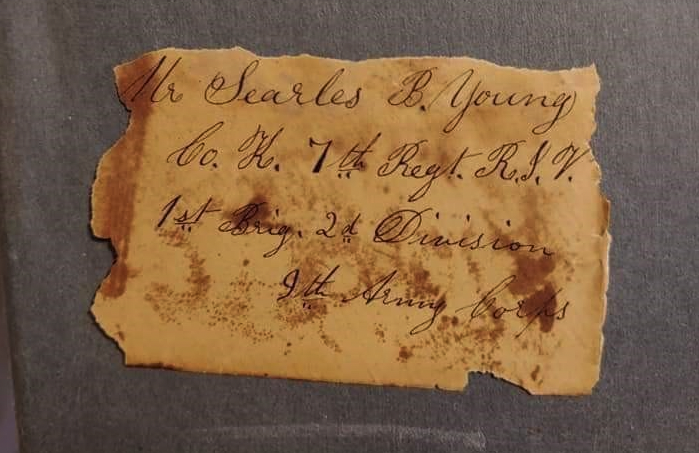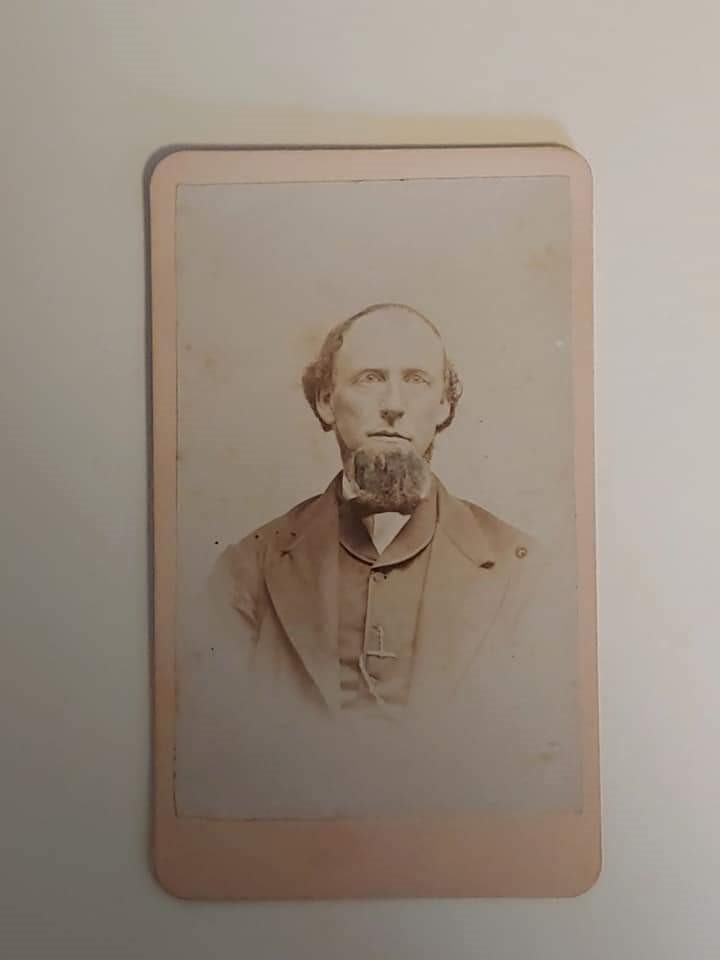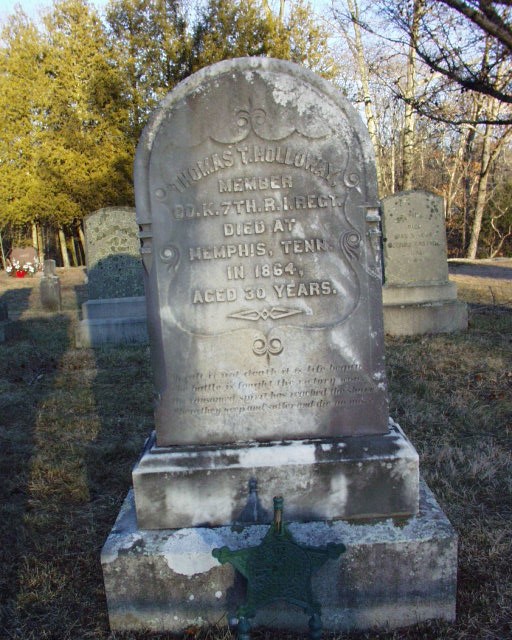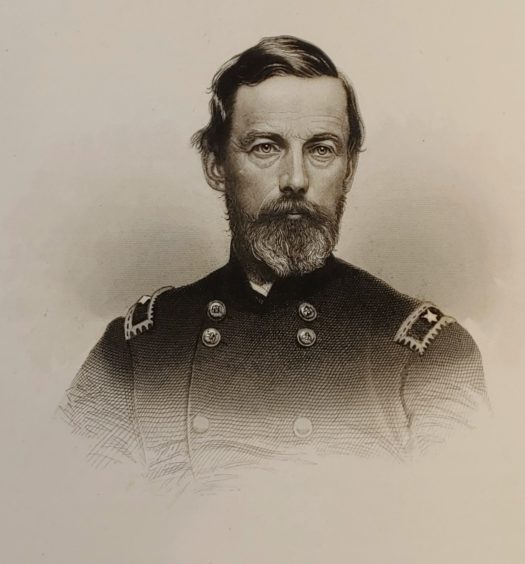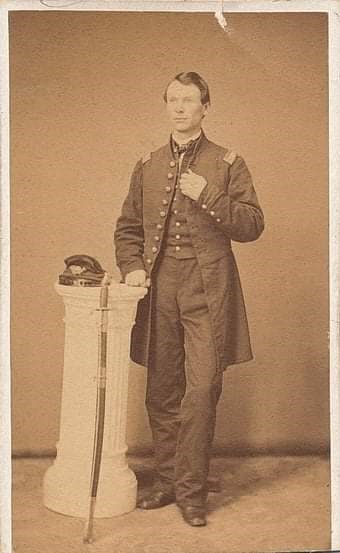Foster, Rhode Island is one of the few places in Rhode Island that maintains a Nineteenth Century charm. Indeed if the Civil War veterans of Foster were to return, they would recognize the villages of Moosup Valley, Hopkins Mill, North Foster, and Clayville that have not changed much since the 1860s. The Foster of then was a rural farming community, along with several mills. Foster was a largely homogenous town, white, native born, with several sects of Baptists whose small white churches still dot the pastoral landscape. With a population of 1,935 in the 1860 census, 179 men from Foster volunteered to serve the Union; thirty-four paid the ultimate sacrifice.[1]
The company was the basic building block of a Union or Confederate infantry regiment during the Civil War. An infantry regiment was composed of ten companies, lettered A through K; the letter J was not used as it looked too close in the period script to I. Companies were recruited in the same communities during the war, or several smaller towns in the same area lumped their recruits together to form a company. While relatives, neighbors, and friends went to war together and quickly formed the bonds of combat veterans, companies being recruited in the same community often had disastrous results; one third of Company G of the Seventh Rhode Island, recruited in South Kingstown, died in the service, a truly terrible rate.
At full strength a company was 100 men. As casualties mounted due to battle and disease, however, most were reduced greatly in number. On June 4, 1864 after the disastrous Battle of Cold Harbor, the Seventh Rhode Island’s Company H had one man left.[2]
The greatest concentration of Foster men served in the Seventh Rhode Island Volunteers. Twenty-four men from Foster volunteered in the summer of 1862 to serve in the regiment. These men were recruited by Ethan Amos Jenks of Foster who grew up on a farm in Foster’s extreme southwest corner. Jenks knew the realities of war, having enlisted in April 1861 as a private in the First Rhode Island Detached Militia; he fought at Bull Run on July 21, 1861. A fellow soldier wrote of him, “Sterling patriotism was the controlling motive of his life. He was quiet, pure, and simple. Little did the men think that the comparatively old and somewhat uncouth subaltern, who had spent almost his entire life upon a farm, would become one of the best, bravest, and most conspicuous of their officers and that he could be relied upon under all circumstances.”[3]
Helping Jenks enlist men in the town was a bounty of four hundred dollars voted upon at a special town meeting by the taxpayers of Foster on August 12, 1862. Initially the town had voted for a bounty of two hundred dollars on August 2, but after this amount did not produce the number of required recruits, the town voted to double it ten days later, putting the four hundred dollars in line with most other Rhode Island towns.
After a year of seeing their fellow Rhode Islanders fight and die in the service, the large bounties being offered were a catalyst to spark men to enlist. They literally amounted to several years’ salary for a farm hand. Despite receiving a bounty, Searles B. Young, who had gone to college to become a Baptist minister, but returned to Foster to farm and raise a family, stated plainly why he went to war. “For many years the slavery question had been before the country. From my childhood I had been taught the evils of slavery and as I grew older, I became an earnest advocate of the anti-slavery cause and in the election of Abraham Lincoln to the presidency.”[4]
For his efforts in recruiting in Foster, Jenks was rewarded with a commission as a second lieutenant in the Seventh. The Foster recruits formed up with other men recruited in Coventry and Scituate to form a full company. After two weeks drilling in the now flooded village of South Scituate, the men were sent to Camp Bliss in Cranston where they received uniforms, muskets, and other equipment. When company letters were assigned, the Coventry, Foster, and Scituate men were designated as Company K. George N. Durfee, son of Rhode Island Supreme Court Justice Job Durfee, was assigned as captain.[5]
Prior to leaving Rhode Island on September 10, 1862, a number of men were discharged from the Seventh, deserted, or otherwise left the regiment. For unknown reasons, two Foster men, John Dorrance and Justin Shippee were assigned to Company C, recruited mostly in Glocester. Nearly fifteen were from Company K were discharged for medical issues. To fill the company up to full strength, ten men from Company A, which had been recruited in Charlestown, Hopkinton, and Richmond were transferred into Company K. Despite these South County additions, Company K maintained its Pawtuxet Valley identity throughout the war.[6]
Despite recruiting the men from Foster, Ethan Amos Jenks never led them in combat. He was assigned to Company H, recruited in Warwick and East Greenwich as a lieutenant and after Fredericksburg became captain of Company I, recruited in Newport and Bristol. He rose to become second in command of the Seventh and was wounded twice in action. On May 18, 1864, at Spotsylvania Court House, Virginia, Jenks singlehandedly saved the Seventh from destruction during the bloody battle by preventing an ill-advised charge against a fortified position.[7]
Company K and the rest of the Seventh were literally bound for hell. First bloodied at Fredericksburg in December 1862, the Seventh went on to see service at Vicksburg and Jackson, Mississippi, in 1863, losing dozens to disease in the swamps. In the spring on 1864, the Seventh went through the meatgrinder of the Overland Campaign, fighting at the Wilderness, Spotsylvania Court House, the North Anna River, Cold Harbor, Bethesda Church, Petersburg, the Weldon Railroad, Hatcher’s Run, and Poplar Spring Church. In 1865 the Seventh garrisoned Fort Hell in front of Petersburg. After the pursuit to Appomattox and the surrender of the Confederacy’s main army, the Seventh returned to Rhode Island and mustered out on June 9, 1865.[8]
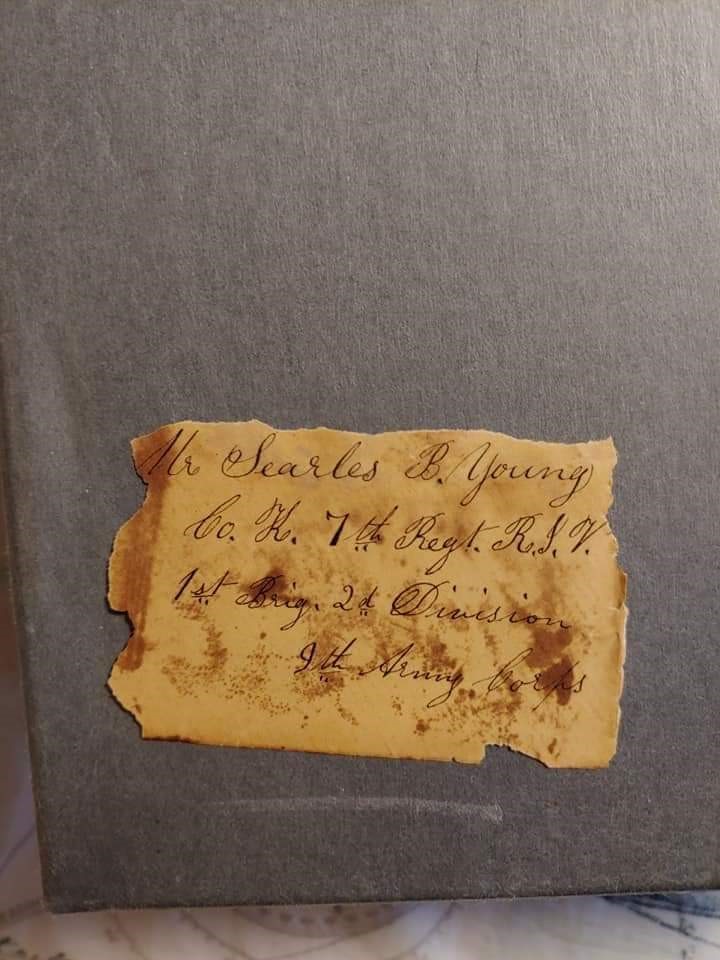
This is a piece of an envelope mentioned in the following quote from Searles B. Young, stained with the blood of Searles B. Young from the wound he received at Fredericksburg. “The Battle of Fredericksburg (in Virginia in 1863) began about noon on Saturday the thirteenth. We were marched out onto a plain and ordered to lie down in a place which was very much exposed to the fire of the enemy. Soon we were ordered forward at double quick. Two fences had been built across the plain and many of the men were killed while climbing over those obstacles. As I was lying on one elbow and tearing a cartridge in order to reload, a rifle-ball from the enemy struck my index finger, cutting it nearly off. It broke my jaw bone, cut my tongue almost half off, and passed out the side of my neck, very close to the jugular vein. As soon as there was a lull in the firing I went to the rear, thinking my best chance to escape was along the railroad track. A high bank protected me for a short distance. Then I came to a place where the ground was level and the firing very severe. I had been crawling on my hands and knees but after resting a little and summoning all my strength I ran across the open space and reached the banks in safety. From here I walked to the city and began a search for our hospital. I was directed to the hospital of another regiment by mistake but was allowed to stay there overnight but nothing was done for my wound. When daylight came, I was obliged to start on my search again. I could not speak but could only show an envelope which had on it my name and the number of my regiment. When my strength was almost exhausted, I found a house where a surgeon was willing to care for me. Here my wound was bathed and dressed and my finger cut off. I was given nourishment which was the first in twenty-four hours.” (Robert Grandchamp Collection)
The following information was transcribed from the Seventh Rhode Island Descriptive Book, held at the Rhode Island State Archives in Providence. A remarkable manuscript, this book chronicles each man who served in the Seventh. Furthermore, I have added burial details gleaned from Findagrave.com and the Rhode Island Cemetery Database. With the exception of Jenks who served in Companies H and I, and Dorrance and Shippee who were in Company C, the following Foster men served in Company K of the Seventh Rhode Island Volunteers. Unless noted, each man served as a private. The man’s age and occupation at time of enlistment is also noted. Furthermore, marital status at time of enlistment is denoted by an “S” for single and “M” for married.
Bennett, George W. Residence, Foster. 42. S. Carpenter. Enlisted Aug. 14, 1862. Mustered in as first sergeant Sept. 6, 1862. Wounded in action, shot in right ankle, at Fredericksburg, VA, Dec. 13, 1862. Sent to hospital and never returned to regiment. Transferred to the Veteran Reserve Corps Oct. 31, 1863. Died May 6, 1881. Interred at Pine Grove Cemetery, Coventry, RI.
Briggs, James A. Residence, Foster. 20. S. Farmer. Enlisted Aug. 18, 1862. Mustered in Sept. 6, 1862. Discharged for disability at West’s Building Hospital, Baltimore, MD, Jan 1, 1863. Died Sept. 9, 1896. Interred at Sand Hill Cemetery, Foster, RI.
Cole, Henry S. Residence, Foster. 33. M. Farmer. Enlisted Aug. 16, 1862. Mustered in Sept. 6, 1862. Killed in action at Fredericksburg, VA, Dec. 13, 1862. Cenotaph in Cole Lot, Foster Cemetery 52, Foster, RI.
Cummings, Chester C. Residence, Foster. 31. M. Farmer. Enlisted Aug. 8, 1862. Mustered in Sept. 6, 1862. Transferred to Veteran Reserve Corps, Oct. 31, 1863. Died 1874. Interred at North Burial Ground, Providence, RI.
Dorrance, John. Residence, Foster. 22. S. Stone cutter. Enlisted Aug. 5, 1862. Mustered in Sept. 6, 1862. Died of typhoid in Second Division, Ninth Army Corps Field Hospital, Windmill Point, at Aquia Creek, VA, Jan. 26, 1863. Interred at Benjamin Cahoone Lot, Coventry Cemetery 101, Coventry, RI.
Farrow, Enos. Residence, Foster. 32. M. Farmer. Enlisted Aug. 16, 1862. Mustered in Sept. 6, 1862. Died of typhoid at Washington, DC, Dec. 3, 1862. Interred at Soldiers Home National Cemetery, Washington, DC. Section H, Grave 3552.
Harrington, William O. Residence, Foster. 32. M. Farmer. Enlisted Aug. 14, 1862. Mustered in Sept. 6, 1862. Mustered out June 9, 1865. Died Mar. 18, 1904. Interred at Moosup Valley Cemetery, Foster, RI.
Holloway, Thomas T. Residence, Foster. 26. M. Farmer. Enlisted Aug. 16, 1862. Mustered in Sept. 6, 1862. Died of Yazoo Fever at Union Hospital, Memphis, TN, Aug. 23, 1863. Interred at Keech-Winsor Lot, Foster Cemetery 17, Foster, RI.
Hopkins, Adoniram J. Residence, Foster. 21. S. Farmer. Enlisted Aug. 12, 1862. Mustered in Sept. 6, 1862. Discharged for disability at Baltimore, MD, Mar. 4, 1863. Died April 7, 1930. Interred at Hopkins Mills Cemetery, Foster, RI.
Hopkins, Ashael A. Residence, Foster. 22. S. Farmer. Enlisted Aug. 9, 1862. Mustered in Sept. 6, 1862. Died of dysentery at Loudon, TN, April 11, 1864. Interred at Tucker Hollow Cemetery, Foster, RI.
Hopkins, John. Residence, Foster. 29. S. Farmer. Enlisted Aug. 16, 1862. Mustered in Sept. 6, 1862. Died of typhoid at regimental hospital at Newport News, VA, Mar. 1, 1863. Interred at Hopkins Lot, Foster Cemetery 74, Foster, RI.
Hopkins, John E. Residence, Foster. 25. M. Farmer. Enlisted Aug. 12, 1862. Mustered in Sept. 6, 1862. Died of dysentery at Memphis, TN, Aug. 17, 1863. Interred at Hopkins Mills Cemetery, Foster, RI.
Jenks, Ethan Amos. Residence, Foster. 35. M. Farmer. Commissioned as second lieutenant, Co. H, Aug. 5, 1862. Mustered in Sept. 6, 1862. Promoted to captain Co. I, Mar. 3, 1863. Brevet major for gallantry at Spotsylvania Court House, VA, May 18, 1864. Wounded in action, shot in leg, at Petersburg, VA, June 19, 1864. Commissioned major June 29, 1864. Never mustered in as such, however, served as major for duration of service. Wounded in action, in shoulder, at Petersburg, VA, Mar. 20, 1865. Mustered out June 9, 1865. Died May 13, 1901. Interred at Tourtellot Family Lot, Johnston Cemetery 22, Johnston, RI.
Potter, George H. Residence, Foster. 34. S. Blacksmith. Enlisted Aug. 14, 1862. Mustered in Sept. 6, 1862. Wounded in action, shot in shoulder, at Fredericksburg, VA, Dec. 13, 1862. Promoted to corporal June 4, 1863. Wounded in action, shot in hand, at Cold Harbor, VA, June 8, 1864. Wounded in action at Poplar Spring Church, VA, Sept. 30, 1864. Promoted to sergeant Mar. 1, 1865. Mustered out June 9, 1865. Died Jan. 28, 1908. Interred at Riverside Cemetery, Sterling, CT.
Prey, Esais. Residence, Foster. 43. M. Farmer. Enlisted Aug. 14, 1862. Mustered in Sept. 6, 1862. Wounded in action, shot in jaw, at Spotsylvania Court House, VA, May 12, 1864, and sent to General Hospital. Discharged for disability at Portsmouth Grove, RI, Nov. 17, 1864. Died Jan. 31, 1911. Interred at Munson Cemetery, Putnam, CT.
Robbins, Philander T. Residence, Foster. 21. S. Farmer. Enlisted July 8, 1862. Mustered in as corporal Sept. 6, 1862. Promoted to first sergeant Jan. 1, 1863. Mustered out June 9, 1865. Died Jan. 8, 1899. Interred at Togus National Cemetery, Togus, ME. Grave 1469.
Rounds, Chester P. Residence, Foster. 22. S. Farmer. Enlisted Aug. 16, 1862. Mustered in Sept. 6, 1862. Wounded in action, shot in hand, at Spotsylvania Court House, VA, May 12, 1864. Absent sick at Portsmouth Grove, RI, from Jan. 1, 1865, until Mar. 1865, when he was transferred to Veteran Reserve Corps. Died 1925. Interred at Pocasset Cemetery, Cranston, RI.
Shippee, Justin. Residence, Foster. 23. S. Farmer. Enlisted Aug. 8, 1862. Mustered in Sept. 6, 1862. Transferred to Veteran Reserve Corps, May 6, 1864.
Shippee, Horace J. Residence, Foster. 42. M. Farmer. Enlisted Aug. 14, 1862. Mustered in Sept. 6, 1862. On detached service at division headquarters from Dec. 1862, until Feb. 1863. In Ninth Corps commissary department from Jan. 1865, until May 1865. Mustered out June 9, 1865. Died Nov. 15, 1894. Interred at Elm Grove Cemetery, North Kingstown, RI.
Simmons, George. Residence, Foster. 40. M. Farmer. Enlisted Aug. 14, 1862. Mustered in Sept. 6, 1862. Wounded in action, in head, at Fredericksburg, VA, Dec. 13, 1862. Sent to Portsmouth Grove, RI, and borne as absent sick until Feb. 1863. Killed in action at Spotsylvania Court House, VA, May 12, 1864. Cenotaph at Walker-Randall Lot, Foster, Foster Cemetery 54, Foster, RI.
Simmons, Isaac. Residence, Foster. 21. S. Farmer. Enlisted Aug. 14, 1862. Mustered in Sept. 6, 1862. Mustered out June 9, 1865. Interred at Pocasset Cemetery, Cranston, RI.
Winsor, Albert A. Residence, Foster. 18. S. Farmer. Enlisted Aug. 16, 1862. Mustered in Sept. 6, 1862. Killed in action Fredericksburg, VA, Dec. 13, 1862. Cenotaph in Keech-Winsor Lot, Foster Cemetery 17, Foster, RI.
Wood, Oliver. Residence, Foster. 41. S. Carpenter. Enlisted Aug. 14, 1862. Mustered in Sept. 6, 1862. Mortally wounded in action at Bethesda Church, VA, June 3, 1864. Died of wounds at Cold Harbor, VA, June 5, 1864. Interred at Cold Harbor National Cemetery. Grave 796. Cenotaph in Line Cemetery, Foster, RI.
Young, Searles B. Residence, Foster. 21. S. Farmer. Enlisted Aug. 14, 1862. Mustered in Sept. 6, 1862. Wounded in action, shot in jaw and arm, at Fredericksburg, VA, Dec. 13, 1862. Discharged for disability at Washington, DC, Feb. 4, 1863. Died Aug. 12, 1925. Interred at North Foster Cemetery, Foster, RI.
* * * *
Of the twenty-four who volunteered from Foster, ten died in the service, eight were discharged or transferred for wounds and disease, while only six completed their service to muster out with the regiment. Remarkably, one Foster soldier, Sergeant George H. Potter survived three wounds and returned to the regiment each time, a truly remarkable occurrence; Potter mustered out with the Seventh and later moved to nearby Sterling, Connecticut.
For the Seventh Rhode Island veterans who returned to Foster, the war both did and did not change them. The survivors, like all Civil War veterans suffered from the diseases and wounds they brought home. In response to a circular sent to the Foster Town Council by the state about the character of the men of the town upon their return home in 1865, Foster Town Clerk George W. Phillips replied, “I am directed by the Town Council, to inform you that it is their opinion that the character of our returned soldiers as citizens, will compare favorably with their character previous to enlistment, probably better.” As sons of hardworking Yankee farm families, the men of Foster did not return with many of the vices other soldiers did, such as drinking issues, gambling addictions, and venereal disease.[9]
The majority of the men from Foster did not feel compelled to join the Grand Army of the Republic or the Seventh Rhode Island Veterans Association. William O. Harrington of Company K, who spent most of the war after Fredericksburg detached as the cook for Company K only attended one postwar reunion of the Seventh. Writing about the Civil War veterans from western Rhode Island, Clarence M. Webster wrote, “They had helped the town do a job and now they were free to live as they pleased. There wasn’t any sense making a to-do over them; they’d been good soldiers, none better, but the war was over. That was what my grandfather thought of the Civil War when he came home from it. It was over.” Indeed, the Civil War became so forgotten in Foster that a memorial to Foster’s Civil War veterans was never erected.[10]
Foster never formed its own Grand Army of the Republic Post, rather those who did join the organization joined Nichols Post 19 in Scituate. Those associated with Nichols Post decorated the graves of Foster’s Civil War veterans each year, often quietly and without ceremony. The only member of Company K to join this Post was Searles B. Young. He survived grievous wounds at Fredericksburg and returned home to become a Baptist minister. Young went on to become post commander, attended the 1913 Gettysburg Fiftieth Anniversary Reunion, led the Nichols Post contingent at the 1913 dedication of the Soldier’s Monument in Scituate, and was the last surviving member of Nichols Post when he died in 1925.[11]
Ethan Amos Jenks who recruited these men to serve in the Seventh had a very successful postwar career. He left the farm in Foster and moved to Providence where he became a lawyer and deputy collector of customs for Providence. Jenks served as president of the Seventh Rhode Island Veterans Association for a several years and prior to his death made a trip to Vicksburg, Mississippi, to find a place for the Seventh to place its regimental monument. He died on May 13, 1901 and on his headstone in Johnston is proudly carved “Major of the 7th Regt. R.I. Vols.”[12]
The last Civil War soldier from Foster and the last surviving member of Company K was Adoniram J. Hopkins. His service in the regiment was relatively short, being discharged for disability in March 1863. Adoniram had joined the Seventh with his brother John Hopkins; John died of dysentery in August 1863, shortly after the Vicksburg Campaign. Adoniram returned to the farm in the village of Hopkins Mills and stayed there the rest of his life. He never joined any veterans group. When Taps sounded for Adoniram J. Hopkins on April 7, 1930, the living story of Company K and Foster in the Civil War was finally over.[13]
Notes
[1] Thanks to the robust Foster Preservation Society, many books have been written about the history of Foster. One of the best to understand the socio-economic factors in the town at the time of the Civil War is Margery I. Matthews, Virginia I. Benson, and Arthur E. Wilson, Churches of Foster: A History of Religious Life in Rural Rhode Island (Foster: Foster Preservation Society, 1978). See also Patrick T. Conley, Rhode Island Profile (Providence: Rhode Island Publications Society, 1982), 33; Ken Carlson, “Foster Civil War Enlistments,” Rhode Island State Archives, Providence, RI. [2] Mark H. Dunkelman, Brothers One and All: Esprit de Corps in a Civil War Regiment (Baton Rouge: Louisiana State University Press, 2004), 15-29. William P. Hopkins, The Seventh Regiment Rhode Island Volunteers in the Civil War 1862-1865 (Providence: Snow & Farnum, 1903), 185-187 and 486-492. [3] Hopkins, Seventh Rhode Island, 346-347. [4] Minutes of August 2, 1862 and August 12, 1862 Town Meeting, Foster Town Hall, Foster Town Hall, Foster, RI; Searles B. Young, “Autobiography,” undated??, Foster Preservation Society, Foster, RI (date??). [5] Patrick Hackett to “Father and Mother,” August 12, 1862, typescript in Robert Grandchamp Collection; Hopkins, Seventh Rhode Island, 517-524. Captain Durfee resigned shortly after Fredericksburg and was replaced by Captain George A. Wilbur of Woonsocket who served as commander of Company K for the rest of the war. [6] Seventh Rhode Island Descriptive Book and Discharge Records, Rhode Island State Archives, Providence, RI; Pawtuxet Valley Gleaner, June 15, 1914. [7] Ethan A. Jenks to Sandoness Jenks, June 27, 1864, Robert Grandchamp Collection; Stephen F. Peckham, “Recollections of a Hospital Steward in the Civil War,” Newport Historical Society, Newport, RI. [date??] [8] For the complete history of the Seventh, see Hopkins, Seventh Rhode Island. [9] William O. Harrington and Searles B. Young, Pension Files, National Archives; Elisha Dyer, Annual Report of the Adjutant General of Rhode Island and Providence Plantations, for the Year 1865, Cor., Rev., and Republished (Providence: E.L. Freeman & Son, 1893), 724-726. This last work is more commonly referred to as The Revised Register of Rhode Island Volunteers. [10] Papers of the Seventh Rhode Island Veterans Association, 1873-1921, Robert Grandchamp Collection; William O. Harrington Letters, North Scituate Public Library, North Scituate, RI; Clarence M. Webster, Town Meeting Country (Binghamton, NY: Vail-Ballou Press, 1945), 138-141. Surprisingly the other north-west Rhode Island towns of Glocester and Burrillville also did not erect Civil War monuments. See R.N. Chevalier and Donna Chevalier, Rhode Island Civil War Monuments: A Pictorial Guide (Pawtucket: Stillwater Books, 2017). [11] Register of the Department of Rhode Island, Grand Army of the Republic, 1888 (Providence: George H. Pettis, 1888); Gideon A. Burgess, Dedication Services at the Owen Soldiers Monument (North Scituate: E.F. Sibley & Co., 1913); Searles B. Young Papers, Foster Preservation Society; Pawtuxet Valley Gleaner, August 14, 1925. A review of the Pawtuxet Valley Gleaner shows little evidence of Memorial Day activities in Foster. [12] Hopkins, Seventh Rhode Island, 347. [13] Pawtuxet Valley Daily Times, August 9, 1930.
